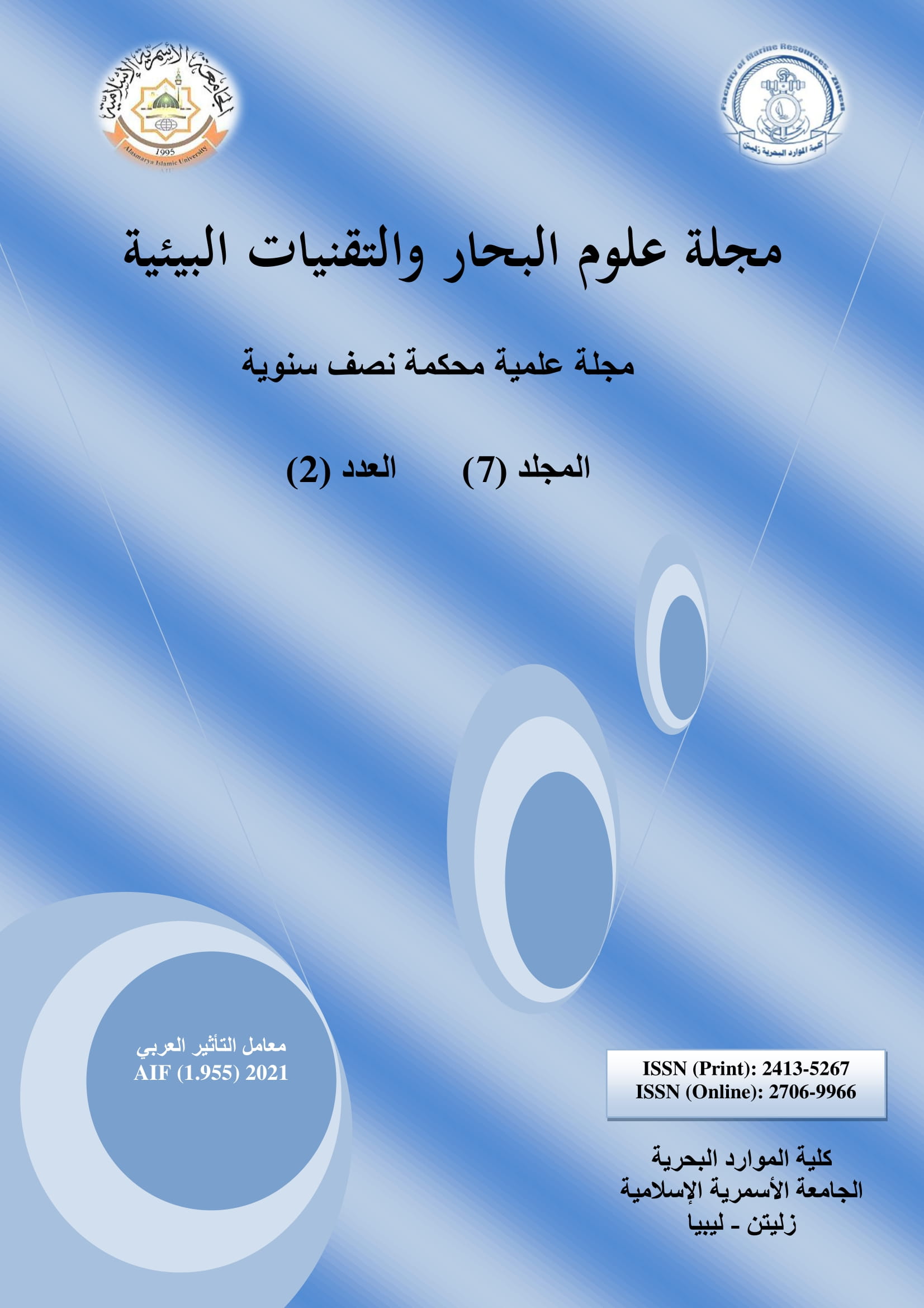التحليل السحني للحفريات النباتية والحيوانية الدقيقة (بالينوفاشيز) لعينات مختارة من الطفل الغنية بالمواد العضوية بالصحراء الليبية: دراسة للاستدلال على بيئة الترسيب القديمة وطاقة التوليد للهيدروكربونات للصخور المصدرية
DOI:
https://doi.org/10.59743/jmset.v7i2.19الكلمات المفتاحية:
التحليل السحني للحفريات النباتية والحيوانية الدقيقة، الطفل الغني بالمواد العضوية، الصحراء الليبية، البيئة القديمة، طاقة توليد الهيدروكربونات للصخور المصدريةالملخص
لقد تم اجراء التحاليل البالينولوجية لعدد ثلاث (3) حزم من عينات بئرية لصخور الطفل (shale) والتابعة للعصر الديفوني والكربوني لاحد الابار النفطية التي تم حفرها بحوض غدامس. هذه الحزم قسمت كالآتي: الحزمة العليا والمترسبة خلال العصر الكربوني على عمق 5,530 قدم, الحزمة الوسطى وتشتمل على عصري الكربوني والديفوني على أعماق 5,600 قدم و 5,780 قدم, أما الحزمة السفلى فتتبع عصر الديفوني على عمق 6,700 قدم. من خلال الدراسة الميكروسكوبية تم تحديد سحنتين بالينولوجيتين هما: P1 (وقد اشتملت على الحزمة العليا والوسطى) و P2 (وشملت الحزمة السفلى). واستنادا على المكونات العضوية التي احنونها تلك السحنتين, تم اعتبار كلتا السحنتين (P1 و P2) كسحنة واحدة متقارنة ترسبت بداخل منطقة الرف المؤكسد المشرفة على الشاطئ (وبالتحديد الرف الاقصى) المتميزة بسواد الطين بها. لقد وجد أن السحنتين المذكورتين بمنطقة الدراسة تماثل العديد من السحنات البالينولوجية بمناطق أخرى من العالم والتي تتميز بسواد المحتويات العضوية (بالينومورفس) ذات الأصل القاري على البحري بالإضافة إلى المحتويات العضوية المعتدلة والمقلة للفيتوكلاست والمواد العضوية الهلامية "AOM" على التوالي والتي تعكس بيئات ترسيب نموذجية بالمناطق الساحلية والحواف البحرية المتأثرة بالنشاط النهري الدلتاوي. بالاستناد على مؤشر اللون لحبيبات الأبواغ وفيما يخص طاقة التوليد للهيدروكربونات للصخور المصدرية ودرجة النضوج الحراري لتلك المواد يمكن القول بأن الحزم الصخرية التي خضعت للدراسة الحالية تتخصص بإنتاج نفط/غاز خلال المراحل المبكرة للنضوج الحراري (نوع الكيروجين II/III) بالإضافة إلى انتاج غاز فقط خلال المراحل ما بعد المتأخرة من النضج الحراري (نوع الكيروجين III/IV).
التنزيلات
المراجع
Atta-Peters D. and Achaegakwo C.A., (2015). Palynofacies and palaeoenvironmental significance of the Albian-Cenomanian succession of the Epunsa-1 well, onshore Tano Basin, western Ghana. Journal of African Earth Sciences, 114.
Batten D.J. & Morrison J. (1983). Methods of palynological preparation for paleoenvironmental source potential and organic maturation studies. In: Costa, L. (ed.) Palynology-Micropaleontology: Laboratories, Equipment and Methods. Bulletin of the Norwegian Petroleum Directorate, 2: 35–53.
Batten D.J. (1996). Palynofacies and paleoenvironmental interpretation, In: Jansonius, J., McGregor, D. C. (Eds.), Palynology: Principles and Applications. American Association of Stratigraphic Palynologists Foundation, 3: 1011-1064.
Boulter M.C. (1994). An approach to standard terminology for palynodebris. In: Traverse, A. (Ed.). Sedimentation of organic particles. Cambridge University Press, Cambridge, 199-216.
Boulter M.C., & Riddick A. (1986). Classification and analysis of palynodebris from the Paleocene sediments of the Forties Field. Sedimentology, 33(6): 871–886.
Burgess J.D. (1974). Microscopic examination of kerogen (dispersed organic matter) in petroleum exploration. GSA Special Paper 153: 19–30.
Carvalho M.A. (2001). Paleoenvironmental reconstruction based on palynological and palynofacies analyses of the Aptian-Albian succession in the Sergipe Basin, northeastern Brazil. Ruprecht-Karls-Universitt Heidelberg, PhD. Thesis, Heidelberg, pp.: 192.
Combaz A. (1964). Les palynofaciès. Revue de Micropaléontologie, 7: 205–218.
Dabros M.J. & Mudie P.J. (1986). An automated microscope system for image analysis in palynology and micropaleontology. Geological Soceity of Canada, 86(1a): 107-112.
Echikh K. (1998) Geology and hydrocarbon occurrences in the Ghadames Basin, Algeria, Tunisia, Libya. In: Petroleum Geology of North Africa (Ed. by D.S. MacGregor, R.T.J. Moody & D.D. Clark-Lowes), Geol.Soc.Lond.Spec.Publ., 132: 109-129.
Ergovac M. and Kostic A. (2006). Organic facies and palynofacies: Nomenclature, classification and applicability for petroleum source rock evaluation. International Journal of Coal Geology, 68: 70-78.
Habib D. (1979). Sedimantology of palynomorphs and palynodebris in Cretaceous carbonaceous facies south of Vigo Seamount. In: Sibuet, J-C., Ryan, W.B.F. (Eds.), Initial Reports of the Deep Sea Drilling Project, 47(2): 451-467.
Hart G. F. (1986). Origin and classification of organic matter in clastic systems. Palynology, 10: 1–23.
Hart G.F. (1994). Maceral palynofacies of the Louisiana deltaic plan in terms of organic constituents and hydrocarbon potential. In: Traverse A. (Ed.). Sedimentation of organic particles (141-176). Cambridge University Press, Cambridge.
Hedi A.M., M’Rabet A., Ghariani H., Ouahchi A., & Montgomery S.L. (2001). Ghadames basin, southern Tunisia: A reappraisal of Triassic reservoirs and future prospectively. AAPG Bulletin, 85(5): 765–780.
Hyde H.A. & Willams D. A. (1944). The right world. Pollen Analysis Circular, 8(6).
Ibrahim M.I.A. (2002). Late Albian-Middle Cenomanian palynofacies and palynostratigraphy, Abu Gharadig-5 well, Western Desert, Egypt. Cretac. Res., 23: 775-788.
Joao G.M. Filho, Taissa R. Menezes, Joalice de Oliveira Mendonça, (2011). Organic Composition (Palynofacies Analysis)"Chapter-5". ICCP Training Course on Dispersed Organic Matter.
Kovach W.L. & Batten D.J. (1994). Association of palynomorphs and palynodebris with depositional environments: quantitative approaches. In: Traverse, A. (Ed.). Sedimentation of organic particles (391-407). Cambridge University Press, Cambridge
Kovach W.L. (1988). Quantitative palaeoecology of megaspores and other dispersed plant remains from the Cenomanian of Kansas, USA. Creataceous Research, 9: 265-283.
Lorente M.A. (1990). Digital image analysis: an approach for quantitative characterization of organic facies and palynofacies. In: Fermont, W. J. J., & Weegink J.W. (eds.). International Symposium in Organic Petrology, Mededlingen Rijks Geologie Dienst, vol. 45, p. 103–109.
Lorente M.R. (1986). Palynology and palynofacies of the Tertiary in Venezuela. Dissertations Botanica, 99: 1-225.
Lucas F.A & Omodolor Hope E. (2018). Palynofacies Analysis, Organic Thermal Maturation and Source Rock Evaluation of Sedimentary Succession from Oligocene to Early Miocene Age in X2 Well, Greater Ughelli DepoBelt, Niger Delta Basin, Nigeria. Journal of Geosciences and Geomatics, 6,(2): 85-93.
Martinez M.A., Pramparo M.B., Quattrocchio M.E., & Zavala C.A., (2008). Depositional environment and hydrocarbon potential of the Middle Jurassic Los Molles Formation, Neuqquen Basin, Argentina: Palynofacies and Organic Geochemical Data, Rev. Geol. Chile, 35(2): 279-305.
Oskay R.G. (2009). Palynofacies Analysis of Coal Bearing Sediments in the Canakkale-Can Basin (NW-TURKEY). Graduate School of Natural and Applied Sciences of Dokuz Eylül University, İzmir.
Parry C.C., Whitley P.K.J., & Simpson R.D.H. (1981). Integration of palynological and sedimentological methods in facies analysis of the Brent Formations. In: Illing, I. V. and Hobson, G.D. (Eds.). Petroleum geology of the continental shelf of North-West Europe. Institute of Petroleum, London, pp. 205-215.
Pearson D.L. (1984). Pollen/Spore Colour 'Standard', Version 2. Phillips Petroleum Company, geology branch, privately distributed.
Quattrocchio M.E., Martinez M.A., Pavisich A.C., & Volkheimer W., (2006). Cretaceous palynostratigaphy, palynofacies and paleoenvironments of well sections in northeastern Tierra del Fuego, Argentina. Cretac. Res., 27: 584-602.
Sebag D., Di Giovanni C., Ogier S., Mesnage V., Laggoun-Défarge F. & Durand A. (2006). Inventory of sedimentary organic matter in modern wetland (Marais Vernier, Normandy, France) as source-indicative tools to study Holocene alluvial deposits (Lower Seine Valley, France). International Journal of Coal Geology , 67: 1-16.
Staplin F.L., (1969). Sedimentary organic matter, organic metamorphism, and oil and gas occurrence: Bulletin of Canadian Petroleum Geology, 17(1): 47–66.
Tissot B.P., & Welte, O.N., (1984). Petroleum Formation and Occurrence. Berlin, Springer-Verlag, 233 p.
Traverse A., (1988). Palaeopalynology: Unwin Hyman, London, 600 p.
Tschudy R.H., (1969). The plant kingdom and its palynological representation. Aspects of Palynology Wiley-interscience, chapter 2, pp. 5-34.
Tyson R.V. (1989). Late Jurassic palynofacies trends, Piper and Kimmeridge Clay Formation, UK onshore and offshore. In: Batten, D.J., Keen, M.C. (Eds.), North-west European Micropaleontology and Paleontology. British Micro-paleontological Society Series, pp. 135-172.
Tyson R.V. (1990). Automated transmitted light kerogens typing by imagine analysis. In: Fermont, W.J. and Weegink, J.W. (Eds.), Proceedings of the International Symposium on Organic Petrology, Zeist, Mededelingen Rijks Geologische Dienst, 45, 139-150.
Tyson R.V. (1993). Palynofacies analysis, In: Jenkins, D.J. (Eds.), Applied Micro-paleontology. Kluwer Academic Publishers, Dordrecht, pp. 153-191.
Tyson, R.V., (1995). Sedimentary Organic Matter, Organic fancies and palynofacies. Chapman and Hall, London, 615 p.
Van Bregen P.F., Janssen N.M.M., Alferink M., & Kerp J.H.F. (1990). Recognition of organic matter types in standard palynological slides. In: Fermont, W.J. and Weegink, J.W. (eds.), Proceedings of the International Symposium on Organic Petrology, Zeist, Mededelingen Rijks Geologische Dienst, 45, 921.
van der Zwan C.J. (1990). Palynostratigraphical and palynofacies reconstruction of the Upper Jurassic to lowermost Creataceous of the Draugen Field, offshore midNorway. Review of Palaeobotany and Palynology, 62: 157-186.
Weller A.F., Corcoran J., Harris A.J., & Ware J.A. (2005). The semi-automated classification of sedimentary organic matter in palynological preparations.Computers & Geosciences, 31(10): 1213–1223.
Zavattieri A,N., Rosenfield U., & Volkheimer W. (2008). Palcies analysis and sedimentary environment of Early Jurassic coastal sediments at the southern border of the Neuquen Basin, Argentina. J. S. Am. Earth Sci., 25: 277-245.
Zobba M., El Beialy S.Y., El-Sheikh H.A., & Beshtawy M.K. (2013). Jurassic-Cretaceous palynomorphs, palynofacies and petroleum potential of the Sharib-1X and Ghoroud-1X wells, North Western Desert, Egypt. J. Afr. Earth Sci., 78: 51-65.
التنزيلات
منشور
إصدار
القسم
الرخصة
الحقوق الفكرية (c) 2021 مجلة علوم البحار والتقنيات البيئية

هذا العمل مرخص بموجب Creative Commons Attribution 4.0 International License.












